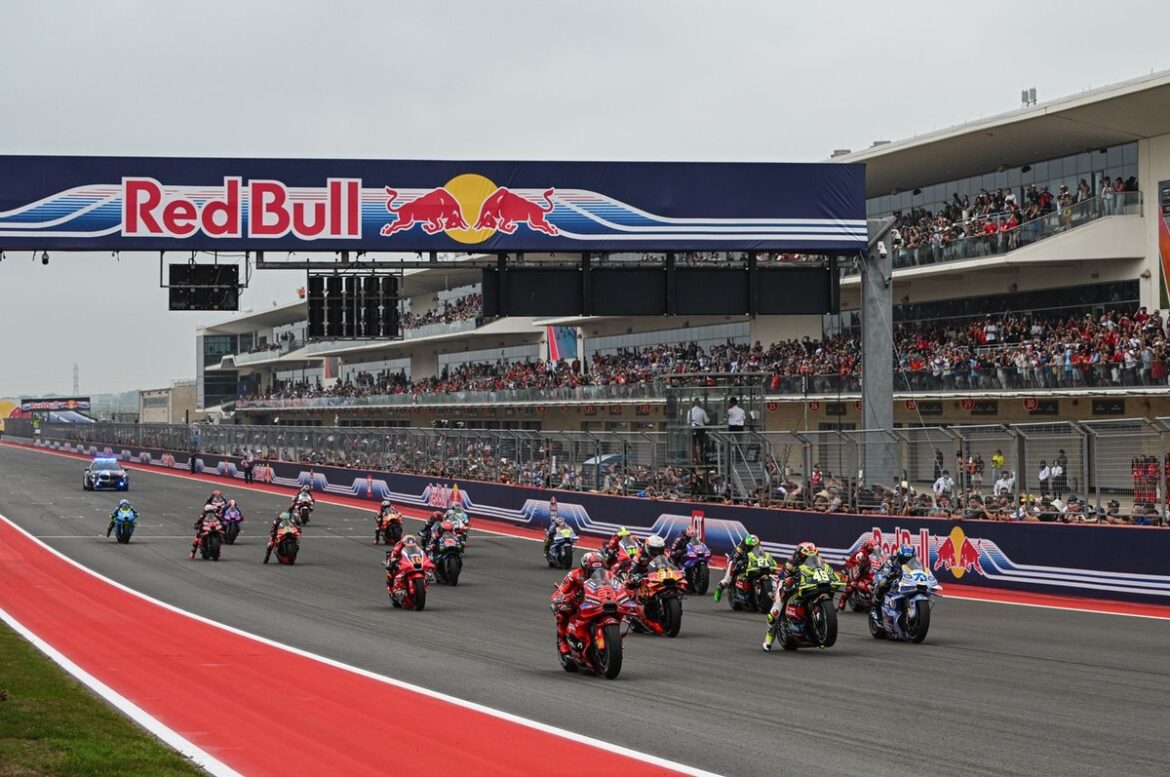In a proactive effort to prevent a repeat of the turmoil seen prior to last month’s Americas Grand Prix, MotoGP teams are gathering today in Jerez to deliberate on modifications to the procedures for race starts. The chaos that unfolded in Austin was largely sparked by Marc Marquez, who made a last-minute dash from the grid to the pits to switch from a wet bike to a dry one—less than two minutes before the warm-up lap was set to commence.
Marquez’s rapid decision was mimicked by several competitors, resulting in a frenzied scramble that compelled race officials to halt the start with a red flag. This intervention provided an escape route for all the riders who, like Marquez, reacted to the quickly drying track conditions at the last possible moment. Typically, such actions would have warranted a ride-through penalty, but the unexpected red flag altered the situation entirely.
Conversely, Ai Ogura, Enea Bastianini, and Brad Binder, the only three riders who opted for slick tires while still on the grid, found themselves at a disadvantage. They received no acknowledgment for their strategic decision, as all other competitors were permitted to switch bikes, return to their original grid positions, and avoid any penalties.
The aftermath of the race saw a surge of criticism and dissatisfaction, especially as it became glaringly evident that neither teams nor riders fully understood the complicated regulations in place. “What transpired in Austin was without precedent, but it will prompt us to reassess certain aspects of the regulations. Our primary goal is to simplify these rules so that everyone involved has a clear understanding,” stated MotoGP race director Mike Webb a week following the event in Texas.
Insights from Motorsport.com reveal that discussions regarding regulatory revisions are already in progress. During the recent race weekend in Qatar, teams convened with the International Road-Race Teams’ Association (IRTA) and MotoGP promoter Dorna to explore various alternatives. One proposal considered at Losail suggested that any rider who departs from the grid within three minutes of the warm-up lap would incur a double long lap penalty. Given the significant advantages available from switching to the appropriate bike for the prevailing conditions, this penalty might not be sufficient to deter riders from making similar choices in the future.
According to Motorsport.com, those involved are eager to amend the rules swiftly—potentially even before the upcoming French Grand Prix in two weeks. Some participants expressed a desire to vote on the proposed changes during the meetings in Qatar. However, teams preferred a more measured approach, opting to reflect on the situation before reconvening in Jerez. They are expected to arrive at a conclusive decision ahead of this weekend’s Spanish Grand Prix.
The chaotic events at the Americas Grand Prix highlighted crucial issues within the MotoGP framework, especially regarding race start protocols. The situation raised concerns about the clarity and enforceability of existing rules, with many stakeholders calling for an overhaul to ensure a smoother and fairer race experience. The ability of teams and riders to adapt to changing track conditions is fundamental to the sport, but the manner in which they can do so must be governed by clear and straightforward regulations.
The influence of track conditions on race strategies cannot be overstated, particularly in a sport that demands quick thinking and decisive action from its participants. The quick transition from wet to dry conditions during the Austin race underscored the need for effective communication and understanding of the rules that dictate what actions are permissible in such scenarios. As the MotoGP community gathers to discuss potential changes, the emphasis will be on creating a framework that supports both competitive integrity and the safety of all participants.
Ensuring that all teams and riders are on the same page regarding regulations is paramount. The recent chaos served as a wake-up call, urging stakeholders to engage in meaningful dialogue about how to prevent similar incidents in the future. The proposed adjustments to race start procedures aim to strike a balance between allowing riders the flexibility to respond to changing conditions while also maintaining a clear set of guidelines that govern their actions.
As MotoGP moves forward, the focus will be not only on refining these procedures but also on fostering a culture of understanding and compliance among all participants. The discussions taking place in Jerez will be vital in shaping the future of race start protocols and ensuring that the spirit of competition remains intact while minimizing the potential for confusion and discord on race day.
The anticipated changes to the regulations are expected to benefit the overall safety and enjoyment of MotoGP events. By simplifying the rules and creating clearer guidelines, the sport can enhance its appeal to fans and participants alike. As stakeholders come together to address these challenges, the hope is that the lessons learned from the Americas Grand Prix will lead to a more streamlined and enjoyable racing experience.
In conclusion, as the MotoGP community reflects on the events in Austin and the subsequent discussions in Jerez, it is clear that the path forward involves collaboration and thoughtful consideration of how best to serve the interests of all involved. By prioritizing clarity and simplicity in the regulations, MotoGP can continue to be a thrilling and competitive sport that captivates audiences around the world.
